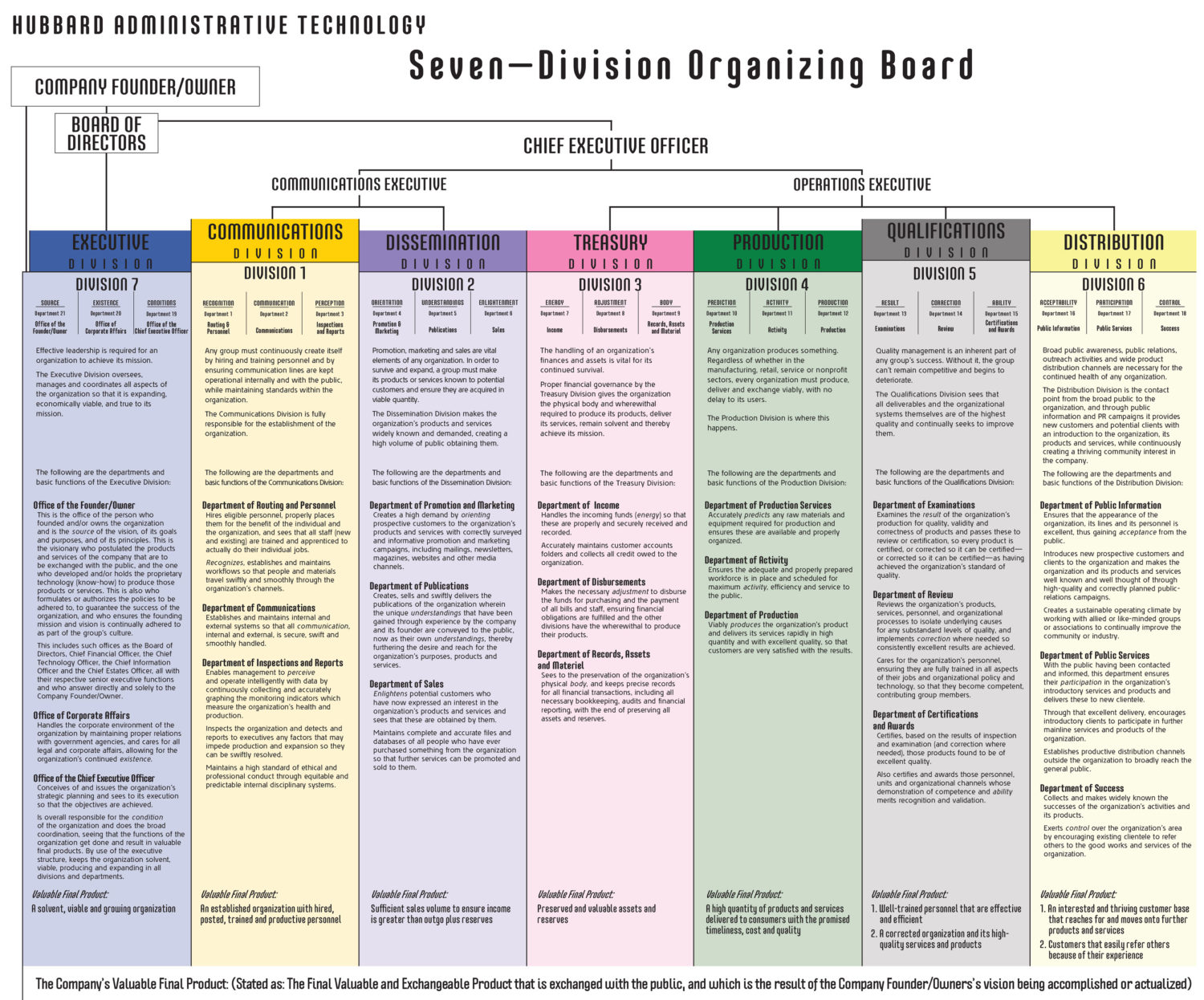Pattern of the Organization
LEARN MOREAt the heart of the Hubbard Management System is the Seven-Division Organizing Board, or “Org Board,” as it is more generally known. Developed by L. Ron Hubbard in 1965, it is a fully four-dimensional pattern of organization delineating duties, positions and functions inherent in all successful activity—be it group or individual.
In fact, the Org Board actually describes the ideal organizational pattern for any activity.
Not a traditional “organizational structure chart,” the Org Board mirrors fundamental natural law. In a landmark discovery, Mr. Hubbard found that all activities follow a sequence known as the Cycle of Production.

This sequence is in no way based upon an arbitrary. Mr. Hubbard found that regardless of size, industry or organizational model, it is an observable natural law that there are seven essential and exact functions necessary for a coordinated effort—to accomplish anything.
These are represented on the Org Board as Divisions 1 through 7 and delineate each function, showing who performs each role, the job titles and duties of every single group member, and the specific Valuable Final Product of each division.
Unique to this Organizing Board is that it is entered from the left and proceeds to the right, starting with Division 1 and moving on through the divisions to Division 6 and then out. (An individual or particle does not flow through Division 7; this division coordinates the activities of the rest of the organization and sees that it properly functions to accomplish its purpose.)
The Org Board can be adapted to every industry and any group activity—from social clubs to sports teams, from small business enterprises to corporate conglomerates, or even from families to government agencies—to greatly increase effectiveness, production and expansion.
In measure of its practical application, organizations can even analyze their current activities against it to discover which organizational functions are missing.
For instance, it is obvious that you would have to be in Communication with people about what you are doing and have your communication lines well established within and outside a group in order to be successful in life.
Likewise, Dissemination would be required to tell people what you are producing, and to promote this.
Further, you must have the physical materials to produce your product, which is your Treasury. This includes the funds to buy the needed materials and a means of purchasing them, as well as caring for your assets.
Then there is Production of your product—the service being provided or item being produced and exchanged in work and in life.
And when the product is complete, Qualifications reviews it to make sure it meets the requirements of a product and, if not, straightens out those factors involved so the product is valuable and can be exchanged. Qualifications also includes the furthering of your own education and training (and that of an organization’s personnel) so as to continuously improve production.
Once the product is verified as qualified, the Distribution Division distributes it, and through proper public relations creates new “public” who can obtain it and makes you and your products known to and desired by them—and thus the cycle repeats, and expansion occurs.
Establishing goals, furthering the purpose, and conceiving and executing planning for the future is cared for by the Executive Division, which also keeps things operating and solves the various problems that arise.
The functions performed by each division are further subdivided into departments, usually three in number, making twenty one in total. Each department has a unique function and product, and these added together accomplish the overall product of the division.
Further underlining the universal practicality of this groundbreaking discovery (referred to as a philosophic machine), one can even look across one’s own life and find whether or not these twenty-one functions are being expressed and performed—and any omission, when found, will expose the cause of heretofore “inexplicable” troubles. Better, with this knowledge one can then take action to remedy these deficiencies and improve one’s life.
This Organizing Board isn’t a static two-dimensional wall chart or plane. It exists in three dimensions—and continues through time. Ideally it would be mounted on a huge cylinder to show that it flows in a circle, with Division 7 meeting Division 1. It is actually a spiral, with Division 7 higher than and adjacent to Division 1. So, to emphasize this fact on the two-dimensional board, Division 7 is placed before the rest of the divisions.
And in emphasis of its name as an Organizing Board, it is configured for continuous action.
— The Editors

